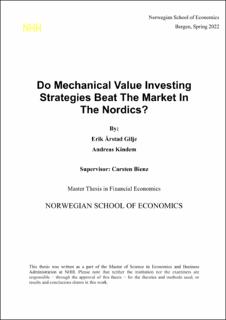Do Mechanical Value Investing Strategies Beat The Market In The Nordics?
Master thesis
Permanent lenke
https://hdl.handle.net/11250/3013141Utgivelsesdato
2022Metadata
Vis full innførselSamlinger
- Master Thesis [4372]
Sammendrag
In this thesis, we study whether three mechanical value investing strategies consistently
generate excess risk-adjusted returns (alpha) on the Nordic exchanges for a Norwegian investor
(returns are reflected in NOK). We backtest: l) Piotroski (2000)'s selection method,
2) Greenblatt (2006)'s "magic formula", and 3) a mechanical strategy employed by the new
Norwegian mutual fund First Veritas (FV). We employ the CAPM, Fama and French's threefactor
model (FF3F), and Carhart's four-factor model (C4F) to measure alpha. The data
coverage allows for backtests from July 2008 to the end of 2021. Before accounting for
transaction costs, the "magic formula" generates statistically significant alpha (on the 5%
level) with the C4F, and the FV strategy generates significant alpha with all models. The
Piotroski method's alpha is statistically indistinguishable from zero with all models. When
controlling for transaction costs (i.e., bid-ask spreads and commission fees), the FV strategy
generates significant alpha with the CAPM and C4F, while the "magic formula" portfolio's
alpha becomes insignificant with all models. Furthermore, when assessing the FV strategy in
a mutual fund setting where we exclude companies below 2000 MNOK market capitalization
and account for fees, the alpha is statistically insignificant with all models.
